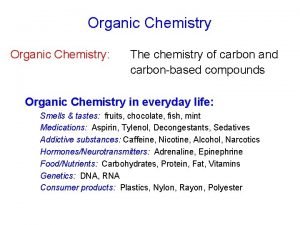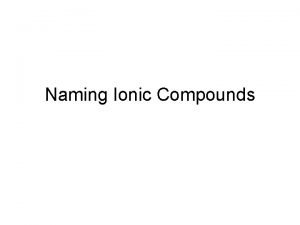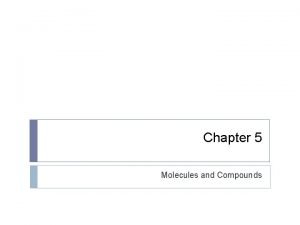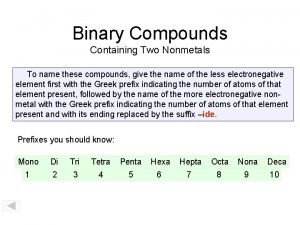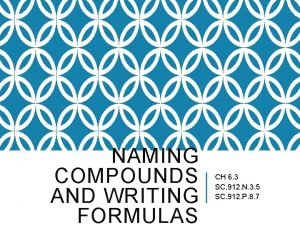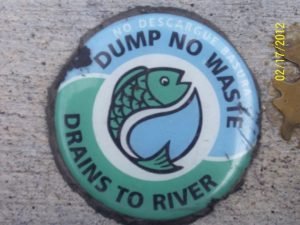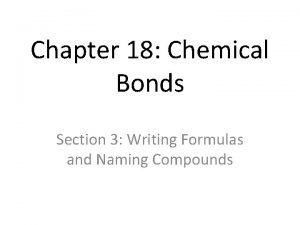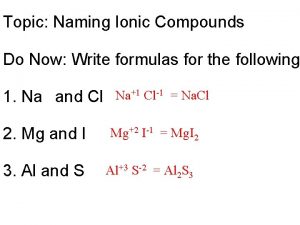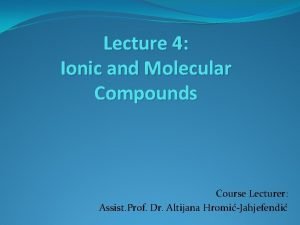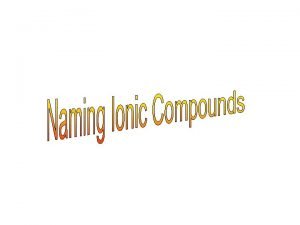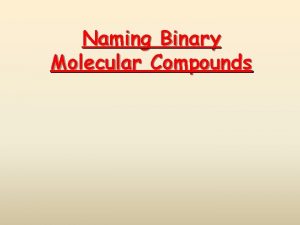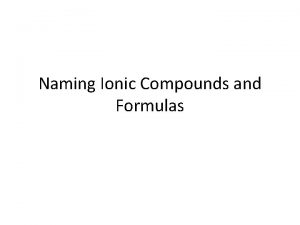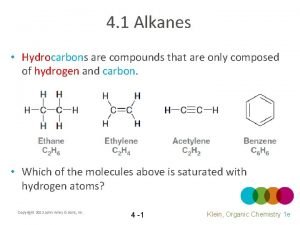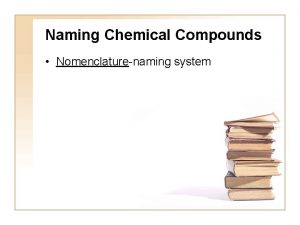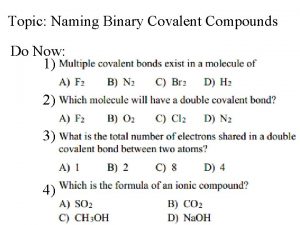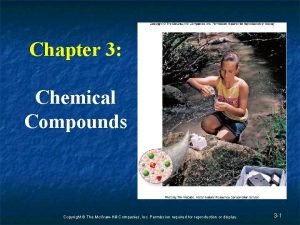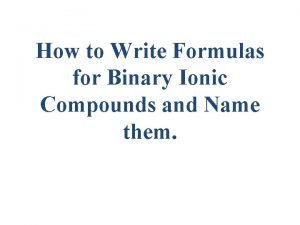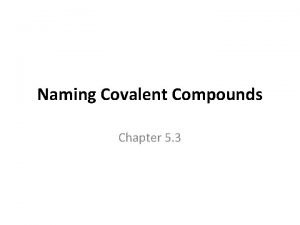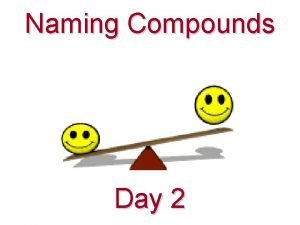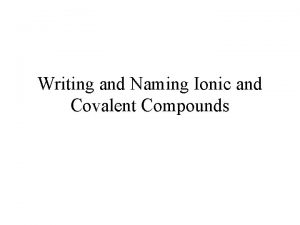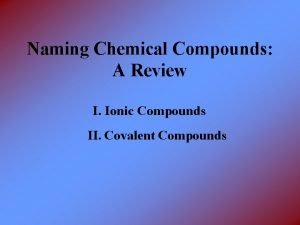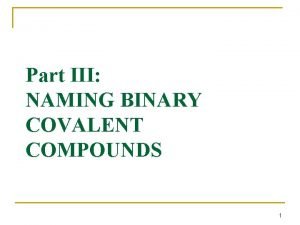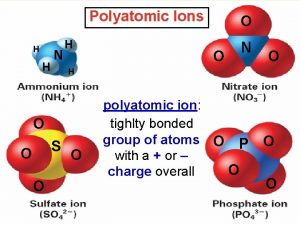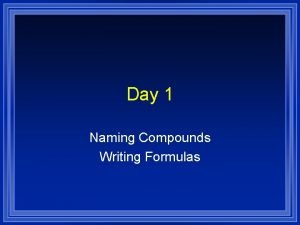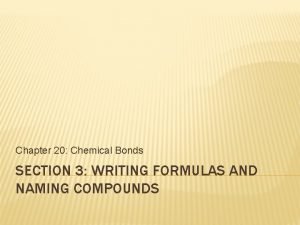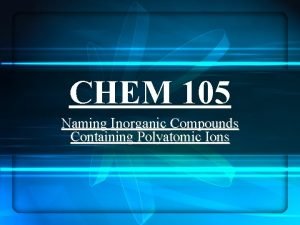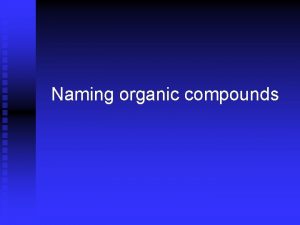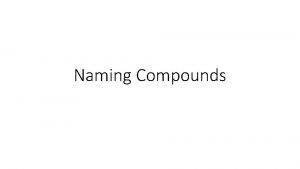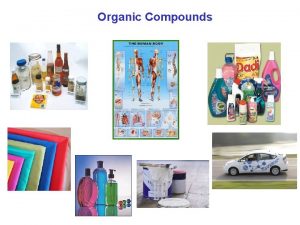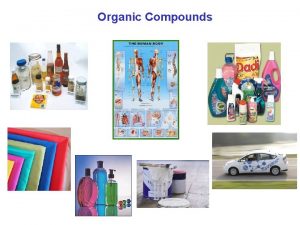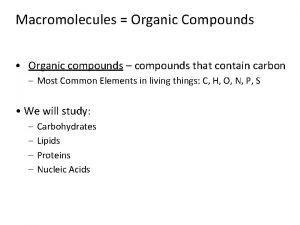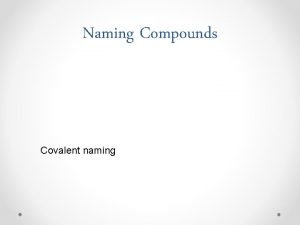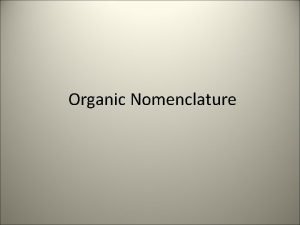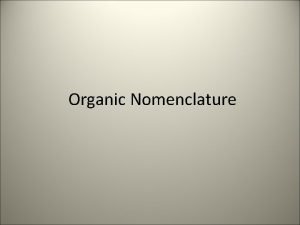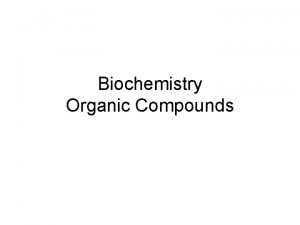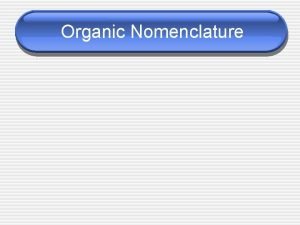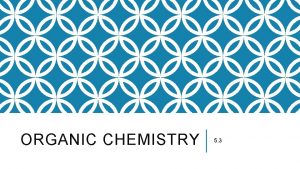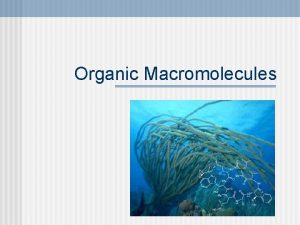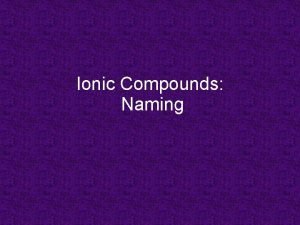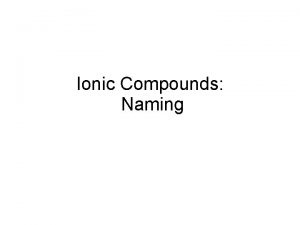Naming Organic Compounds 1 Naming Organic Compounds Originally







































- Slides: 39

Naming Organic Compounds 1

Naming Organic Compounds • • Originally compounds were named based on their source or use Many organic compounds were given common names which are still in use However many ambiguities resulted With the large number of organic compounds, a method for systematically naming them is very important 2

IUPAC Names • • • The International Union of Pure and Applied Chemists (IUPAC) developed a system for naming organic compounds. This system eliminated many of the ambiguities that plagued earlier naming systems Common names for many substances are still widely used 3

Naming Hydrocarbons using the IUPAC System A series of prefixes are used to designate the number of carbon atoms in a carbon chain meth 1 C hex 6 C eth 2 C hept 7 C prop 3 C oct 8 C but 4 C non 9 C pent 5 C dec 10 C 4

Naming Alkanes • • For straight chain hydrocarbons. The prefix indicates the number of carbon atoms. The suffix ane is added to designate that the compound is an alkane 5

Naming Alkanes with branched chains • • For branched chain hydrocarbons, identify the longest consecutive (straight) chain first. Then name the side chains or branches. The name of the branches end in “yl” and go before the name of the straight chain -methylpropane dimethyl propane methyl butane 6

Alkenes • • • Alkenes have one (or more) carbon to carbon double bonds When there are 4 or more carbon atoms in a chain, the location of the double bond is indicated by a number. Numbering the location of the double bond(s) takes precedence over the location of side chains 1 butene 2 -butene methylpropene 7

Isomers-Alkenes & Alkynes • The rigid structure of alkenes and alkynes has an immediate and important consequence: a new kind of isomerism. • There is no rotation about the double or triple bond.

Cis and Trans Isomers

Cis & Trans

Cis & Trans-Your Turn cis-3 -hexene trans-3 -octene trans-2 -heptene cis-4 -octene

Aromatic Hydrocarbons Benzene

Aromatics • An aromatic molecule is a molecule containing one or more benzene rings.

Naming Aromatics • The naming of simple aromatic compounds formed by adding groups to a benzene ring is almost identical to the naming procedure for other cyclic hydrocarbons.

Aromatic Examples

Your Turn ethylbenzene 1 -bromo-4 methylbenzene 1 -ethyl-3, 5 dimethylbenzene 1 -ethyl-4 methylbenzene

Naming Compounds With Functional Groups Various functional groups have unique suffixes that designate the functional group. The functional group takes precedence in numbering the carbon chain. Branches to the carbon chain are named in the usual manner. alcohols “ol” Amides “amide” Aldehydes “al” Amines “amine” or amino as a prefix Ketones “one” Ethers ethoxy as prefix Esters “oate” Carboxylic Acids “oic” 17

Alcohols

Alcohols 1 - Propanol Suffix = “ol” 2 - Propanol 2 -methyl-2 -propanol 19

Alcohols-Your Turn 2 -propanol 2 -butanol 2 -methyl-2 -propanol 2 -chloro-1 -cyclobutanol

Aldehydes and Alkanals Suffix = “al” Propanal Note that the aldeyhde group is always on an end carbon or carbon 1 21

Aldehydes methanal 2 -methylpentanal benzaldehyde

Ketones or Alkanones Suffix = “one” Propanone (also known as acetone) Butanone (also known as methyl ketone) 2 -Pentanone (note the number is necessary Because the C=O could be on carbon 2 or carbon 3) 23

Ketones 3 -hexanone cyclohexanone

Carboxylic Acids Suffix = “oic” Butanoic acid Note that the acid group (called a “carboxyl”) is always on an end carbon or carbon 1 25

Carboxylic Acids methanoic acid butanoic acid

Esters Suffix = “oate” 27

Esters ethyl butanoate butyl ethanoate There are two branches. The branch with the carbonyl gets the suffix

Amides Suffix = “amide” butanamide Note that the amide group is always on an end carbon or carbon 1 29

Amides ethanamide hexanamide 3, 3 -dimethylbutanamide

Amines Suffix = “amine” Or prefix = “amino” Propylamine or 1 -aminopropane 2 -propylamine or 2 -aminopropane 2 -methyl-2 -propylamine or 2 -methyl -2 - aminopropane 31

Amines aminoethane or ethylamine 1, 4 -diaminobutane 2 -aminopentane

Ethers Suffix = “oxy”on first branch Ethoxyethane (diethylether) Ethoxybutane (ethylbutyl ether) 33

Ethers ethoxyethane methoxypropane 1 -methoxy-3, 3 -dimethylbutane

Aromatic Compounds With Functional Groups Benzoic acid 2 hydroxybenzoic acid 3 bromobenzoic acid 35

Nitriles have a cyanide group. The name is based on the longest carbon chain that includes the carbon atom in the nitrile group. 36

Thiols 37

Summary of Functional Groups Note: Be able to recognize the functional groups in larger molecules and know how to name simpler ones. Practice Questions page 240 -244 (Hebden) no assignment

Finis End of Chemistry 11 Thank You for being a Great Class! Congratulations!!
 Oxo functional group
Oxo functional group 5 isomers of hexane
5 isomers of hexane Stock system naming
Stock system naming Concept 2 notes naming ionic compounds
Concept 2 notes naming ionic compounds Naming molecular compounds
Naming molecular compounds Nonmetal prefixes
Nonmetal prefixes Naming and writing formulas for molecular compounds
Naming and writing formulas for molecular compounds Flowchart for naming binary compounds
Flowchart for naming binary compounds Writing formulas and naming compounds section 3
Writing formulas and naming compounds section 3 Di vs bis
Di vs bis Naming chemical compounds flowchart
Naming chemical compounds flowchart Naming molecular compounds
Naming molecular compounds Binary ionic compounds
Binary ionic compounds Binary molecular
Binary molecular Chemical
Chemical Naming binary compounds ionic
Naming binary compounds ionic Naming compounds
Naming compounds Carbon monoxide formual
Carbon monoxide formual Alkanes formula
Alkanes formula Writing formulas (criss-cross method examples)
Writing formulas (criss-cross method examples) Naming type 2 binary compounds
Naming type 2 binary compounds Naming binary covalent compounds
Naming binary covalent compounds Cs2n compound name
Cs2n compound name Naming molecular compounds
Naming molecular compounds Rules for naming ionic compounds
Rules for naming ionic compounds Ionic compounds list
Ionic compounds list Phosphorus pentafluoride covalent compound formula
Phosphorus pentafluoride covalent compound formula Naming compounds working backwards
Naming compounds working backwards Naming ionic vs covalent compounds
Naming ionic vs covalent compounds Ionic compounds review
Ionic compounds review Covalent bond naming
Covalent bond naming Unit 3 ionic bonding webquest answer key
Unit 3 ionic bonding webquest answer key Naming binary compounds covalent
Naming binary compounds covalent Polyatomic ion charges
Polyatomic ion charges Tetraiodine nonaoxide formula
Tetraiodine nonaoxide formula Section 3 writing formulas and naming compounds
Section 3 writing formulas and naming compounds Naming compounds containing polyatomic ions
Naming compounds containing polyatomic ions Writing names for ionic compounds
Writing names for ionic compounds Flowchart for naming binary compounds
Flowchart for naming binary compounds Naming binary ionic compounds
Naming binary ionic compounds

